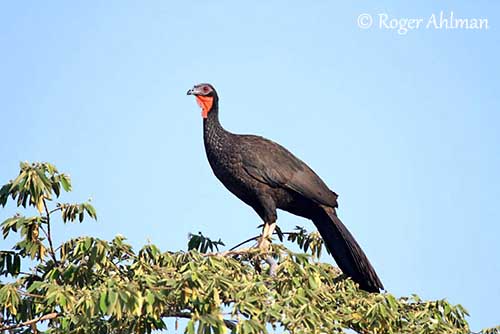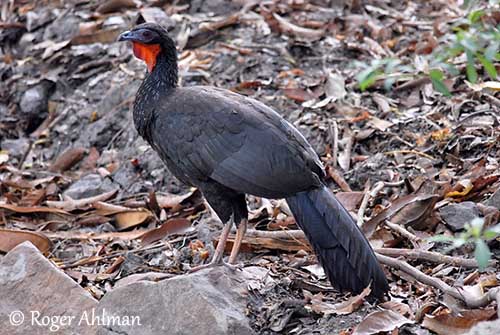
Fr: Pénélope à ailes blanches
Ang: White-winged Guan
All: Weißschwingenguan
Esp: Pava Aliblanca
Ital: Penelope alibianche
Nd: Witvleugelsjakohoen
Sd: Vitvingad guan
Photographer:
Roger Ahlman
Pbase Galleries Peru and Ecuador
Text by Nicole Bouglouan
Sources:
HANDBOOK OF THE BIRDS OF THE WORLD Vol 2 by Josep del Hoyo-Andrew Elliot-Jordi Sargatal - Lynx Edicions - ISBN: 8487334156
BirdLife International (BirdLife International)
Neotropical Birds – Cornell Lab of Ornithology
Wikipedia, la enciclopedia libre
Conociendo Nuestras Aves – Perú – Ministerio del Ambiente
White-winged Guan
Penelope albipennis
Galliformes Order – Cracidae Family
INTRODUCTION:
The White-winged Guan belongs to the genus Penelope, included in the subfamily Penelopinae within the family Cracidae.
This species is Critically Endangered. Discovered in 1876, it has been presumed extinct very quickly. Rediscovered in 1977, it is still critically threatened by habitat loss and hunting. The main goal is to reintroduce this species into natural suitable habitats and some measures are already underway.
DESCRIPTION OF THE BIRD:
Biometrics:
Length: 70-85 cm
Weight: 1750 g
The adult resembles a black turkey. It has blackish-brown plumage overall. On the wings, we can see the conspicuous white primaries, conspicuous in flight. The long tail is blackish-brown. The neck is flecked buffy-white.
On the underparts, the plumage is blackish-brown, with some fine pale streaks on the breast. The underwings show the same white pattern in primaries.
On the blackish head, the bare skin of lores and eye-ring is purplish. On the throat, a bare red-orange double-lobed dewlap floats on the upper neck.
The strong bill is blue with black tip. The eyes are brown. Legs and feet are pale pinkish.
Both sexes are similar.
The juvenile is pale greyish before fledging, but it shows pale tips on wing coverts, like a band.

RANGE:
The White-winged Guan lives in very restricted range, in extreme North-western Peru. This species survives in Lambayeque, Cajamarca and Piura. Some populations may persist in Tumbes.
HABITAT:
The White-winged Guan lives in dry forested slopes and ravines from 300 to 900 metres of elevation. It prefers valleys with permanent water, and dry deciduous forest with dense covert. It may frequent cultivated areas where it can find some food. Formerly, this species occurred in coastal forests and mangroves where it spent the warm hours of the midday.

CALLS AND SONGS: SOUNDS BY XENO-CANTO
The White-winged Guan utters deep, hoarse, nasal “och…och…och” during the breeding season.
It is a noisy bird, producing varied sounds such as grunts, growls, cackles, yelps and crows. All these sounds accompany different behaviours such as courtship displays and mating, and it is also used as contact within the flock, including territorial defence and alarm calls.
The guans do not utter true songs which are replaced by particular wing-drumming during the flight displays.
BEHAVIOUR IN THE WILD:
The White-winged Guan is mainly vegetarian, feeding on ripe fruits, berries and pods. It may also consume flowers, as whole or only the petals, buds, leaves and seeds extracted from the fruits. It also takes vegetables in cultivated areas, and some insects, but not often. Its diet varies, depending on the season.
They often forage in pairs or small family groups. Outside the breeding season, larger foraging groups of up to ten birds can be seen. The food items are taken with the bill from the vegetation, but also from the ground for fallen fruits, seeds and some insects and invertebrates. Usually, the guans are mainly arboreal, but when the food is less abundant, they feed on the ground.
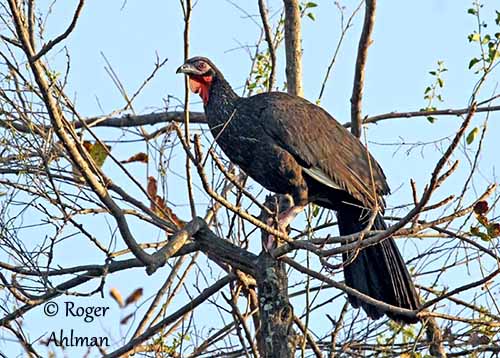
The White-winged Guan performs characteristic wing-drumming flights in the early morning, hopping from perch to perch. It begins its activities before dawn, and performs these flight displays in the darkness, before sunrise. This behaviour is closely related to the breeding season, but it can be observed sporadically during the year.
The wing-drumming of the guans is unique among the Cracidae. This is a special flight. The bird is perched in tall tree. It flies off and performs a brief glide in the open, and produces this wing-whir during about three seconds. This sound is provided by very rapid wing-beats (twice as fast as in regular flight). Then, it glides to another perch, usually lower than the previous. These flight displays occur over 50 to 170 metres in distance.
An individual may perform this behaviour several times in the same session while changing of perch. This behaviour is also used to maintain and strengthen the pair bonds.
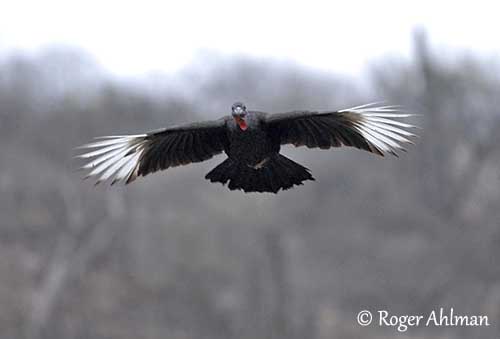
After these displays, the birds drink at the bottom of the ravines where they live. They rest in shady place when the temperature increases at midday, and return to their feeding areas in the late afternoon.
They roost in trees, at mid-level, well-hidden among the foliage. The roost may vary day after day, following the wandering movements of the species.
The White-winged Guan is sedentary, but some movements may occur locally and seasonally, and are mainly related to the rains.
Like other Cracidae, it has moderate capacity for flight, and sustained flights are rare. But it is able to perform long glides after very active wing-beats, with the help of the long tail as support.
The bird climbs up through the branches, and when it reaches the canopy, it flies off again until to be too much low. And it climbs up again.
REPRODUCTION OF THIS SPECIES:
The peak of the breeding season occurs mainly in spring, but eggs can be laid almost at any time of the year.
The nest is very often placed among the vegetation, in tree or bush, at different heights. Both mates build it, at about 2 to 5 metres above the ground in the dense forest.
This structure is relatively small for this large bird. It is made with sticks, twigs, leaves and other plant materials. The inner part is often lined with fresh vegetation.
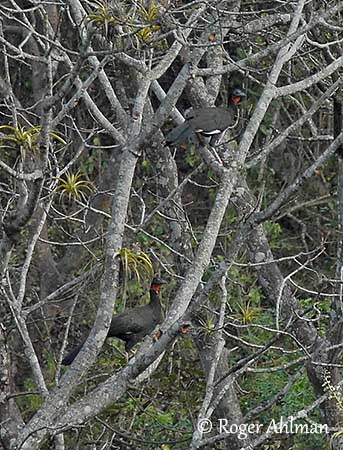
The female lays 2 to 3 eggs. The incubation is usually performed by the female while the male remains in the surroundings, watching for potential danger. The incubation lasts about four weeks.
The chicks are covered with yellowish and black down on upperparts, and paler on underparts. They are precocial and leave the nest very soon after hatching. They are fed by both parents the first days, but they feed themselves progressively, although the parents sometimes provide them some food.
PROTECTION / THREATS / STATUS:
The White-winged Guan is threatened by habitat loss (clearance for agriculture expansion and logging) and overhunting for consumption. Several predators such as raptors also take some numbers of these birds. This species and its habitat are now protected, but illegal hunting continues in some parts of the range.
Reintroductions of this species into suitable areas across the former range are underway.
With a population estimated at 100/170 mature individuals (2012), the White-winged Guan is classified as Critically Endangered species.
